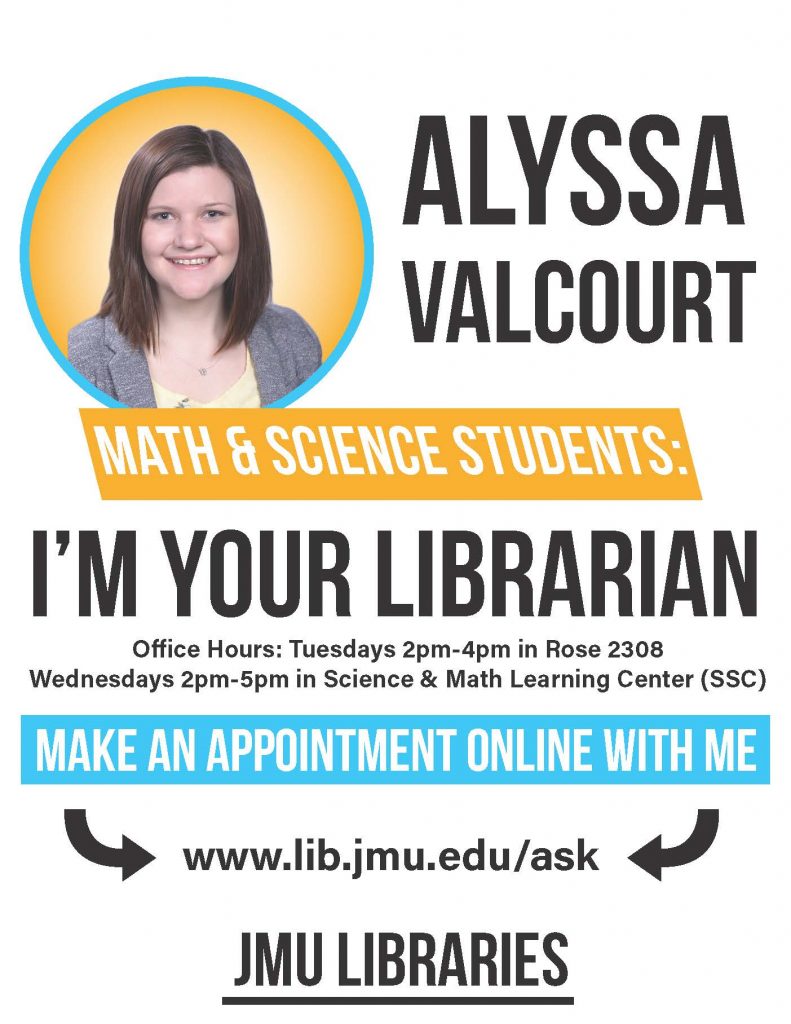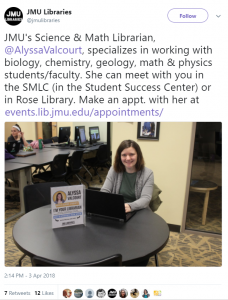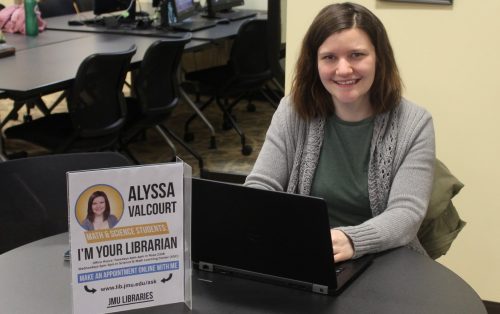As a first-year science and math librarian at James Madison University, I have been searching for ways to build relationships with over 1,700 students and 163 faculty members. These relationships can lead to trust and lead me into more classrooms and working with more faculty than I currently do. It can also lead to more uncommon collaborations with STEM-related student organizations, labs, or even possibly field studies.

So, the one goal this year was (and is) to be visible to students and faculty. I want both groups to know that I exist — and that I am here to support their research interests, not only inside the classroom, but beyond. I want them to realize that librarians can help them access resources that they might not always associate with a librarian (such as online resources or to find ways to learn data management skills).
It would have been easy to stay in the library for all my office hours. But stepping out and becoming more visible has been rewarding. Students usually see librarians in the library, or in class for a quick presentation. This is exactly why I like getting out of the library.
Roving Librarians
During the fall semester, my office hours were held in the library. For spring semester, I wanted to find a way to hold office hours in an area that would allow me to connect with students and faculty. I would have more of a presence and could spark conversations and questions. While I have been able to build relationships with students and faculty through embedding myself in classroom courses, I wanted to find other ways to create meaningful relationships
I chose the University’s Science and Math Learning Center (SMLC), where I can meet with a variety of students and faculty from different departments. I met with the interim director of the SMLC to discuss what I could do to benefit their center and what I could achieve.
The conversation was positive and there was no hesitation on allowing me to embed myself in their space. We are both organizations on campus that support student success, and by supporting one another, we hope to bring more students to the SMLC while also utilizing library services. We looked at the busiest days and hours, and I chose my embedded hours to coincide with when there was the most student traffic.

Meeting And Greeting The Constituents
I then met with the faculty coordinators in the SMLC and I explained how I could support them, and that I was not just about books. I provided examples of databases and other library subscriptions, to help tutors and students. I also explained how I could help them find resources to build up the SMLC’s mentor-peer tutor relationships.
Lastly, I met with the tutors. Many did not know that they had a librarian who provided specific services to their majors. There were few who ever had a librarian visit any of their classes, and had never imagined a mobile librarian offering support services.
I spread the word about my embedded location to the science and math students and faculty, via email, flyers, and social media, among other channels.

What This Librarian Gained
By embedding myself into the SMLC, I created relationships with students and faculty — ones that would have been impossible had I remained in my office. I helped the faculty that work in the SMLC find resources on mentor support for the tutors. I provided information about access to resources they did not realize the library had.
A few peer tutors have also asked questions. Some are as simple as “Where do I even check out a book in the library?” Sometimes they asked questions more complex, such as if students can be part of a library event — or how I make the decisions to add or remove items from our collections.
Future Tense
By embedding myself in a physical space this first year as a librarian, I have been able to build foundational relationships with students and faculty in science and math. I have learned that to reach both students and faculty, it helps if you introduce yourself to them in person and show a genuine interest in what they do in order to explain how you can help them.
When students see me in their workspaces, outside of the usual library location, maybe they will see me more as an everyday resource — and not as a last-resort tool to use. I want to be part of their community, so I can help them find the right resources to discover new things in their own fields.
Come fall semester, I hope to continue to embed myself in the SMLC. I also want to find a location in the science building to embed myself in, instead of my library office. As I learn more about the faculty and students whom I serve, I want to become more visible and known.
By choosing a second location, where many of my faculty and students are, I hope for more impromptu conversations and serendipitous opportunities to arise. I also hope that it will allow me to be someone who is part of their community, and who is there to help them.


